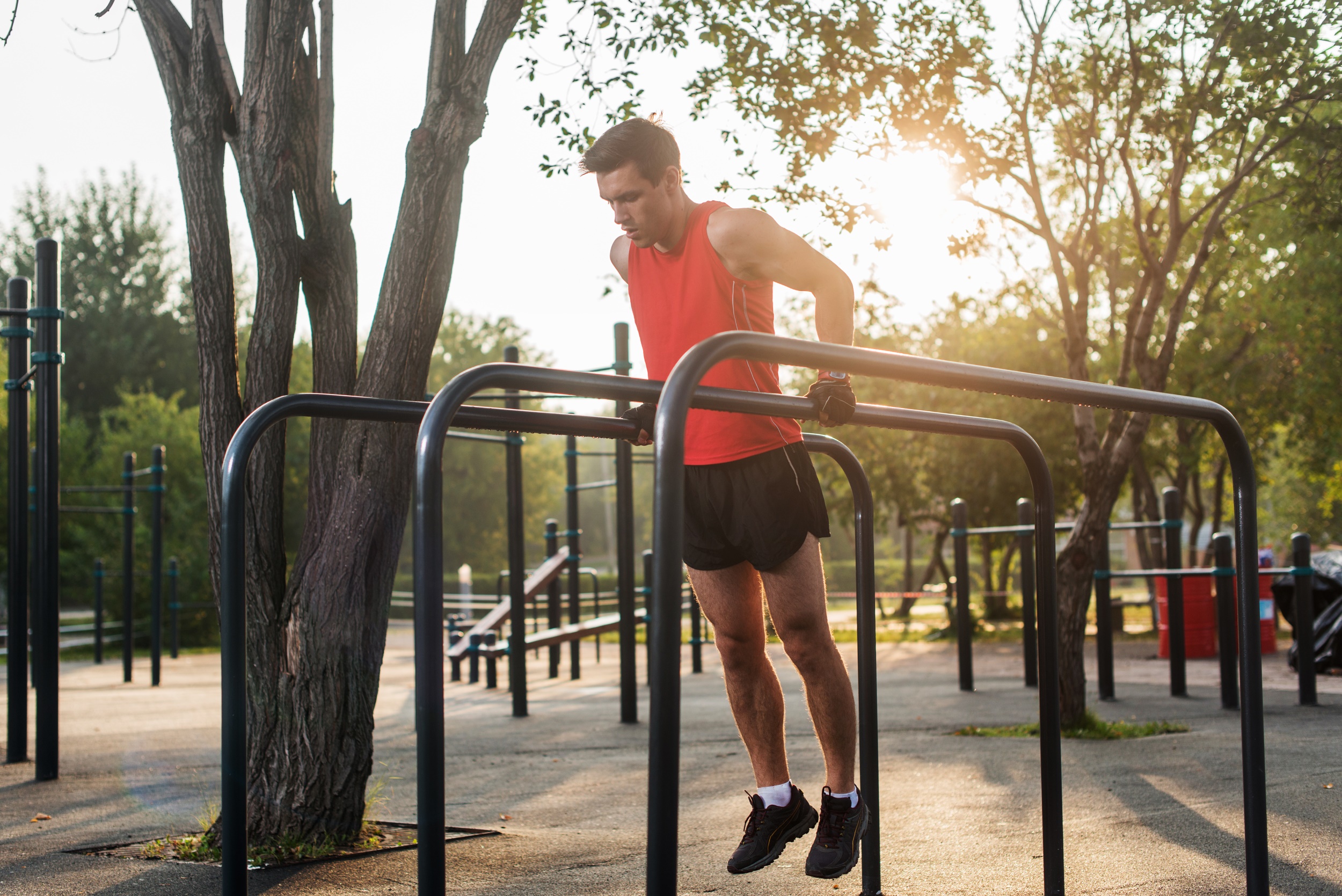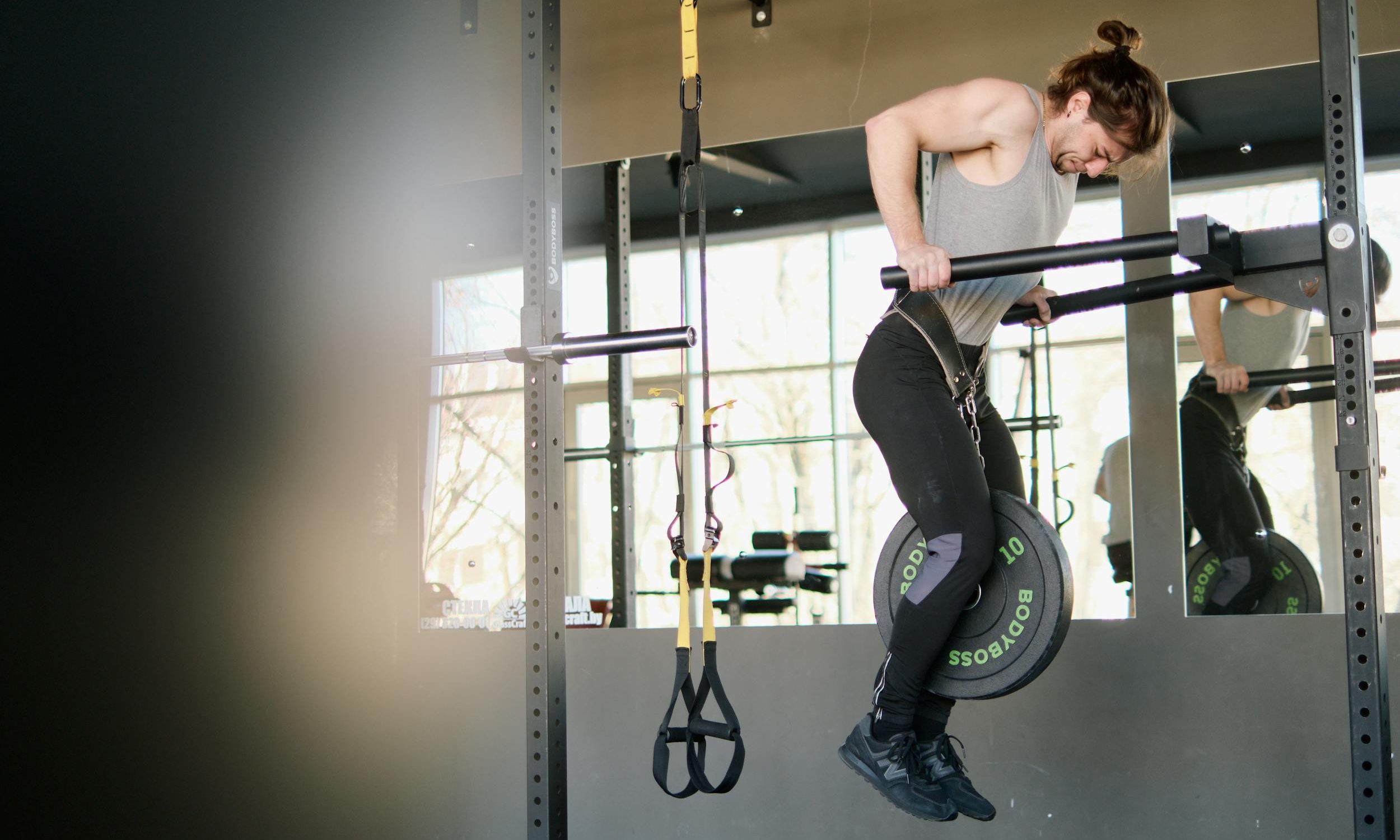A dip station can be commonly found in gyms and parks, and it is a simple piece of equipment that is designed for those wanting to perform tricep dips. While it is meant for a singular exercise, you can actually create a full-body workout using only a dip station.
As a personal trainer, I have worked with many clients who had limited access to workout equipment, leading them to believe that they couldn’t get in an effective training session. If you only have access to this one piece of equipment, keep reading to discover eight dip station exercises for a full-body workout!
5 dip station exercises that target the upper body

Triceps dips
Instructions:
- Grip the dip bars firmly with your palms facing inward.
- Lift your body and straighten your arms, keeping your legs bent or straight.
- Lower your body by bending your elbows until your upper arms are parallel to the ground.
- Push through your palms to extend your arms and return to the starting position.
Recommended sets and reps: 3 sets of 10-12 reps
Chest dips
Instructions:
- Grip the dip bars with your palms facing inward, arms straight, and elbows locked.
- Lean your torso slightly forward, keeping your legs either bent or straight.
- Lower your body by bending your elbows, aiming to bring your chest down toward the bars.
- Press up through your palms to return to the starting position, focusing on squeezing your chest.
Recommended sets and reps: 3 sets of 8-10 reps
Negative dips
Instructions:
- Position yourself at the top of a dip, with your arms straight and body lifted.
- Slowly lower your body in a controlled manner for 3-5 seconds.
- Once your upper arms are parallel to the ground, push back up into the starting position.
Recommended sets and reps: 3 sets of 5-6 reps
Assisted dips
Instructions:
- Attach a resistance band to the dip bars, placing it under your knees or feet.
- Grip the bars with palms facing inward and arms fully extended.
- Lower your body in a controlled motion, feeling the band assist as you descend.
- Push up through your palms to return to the starting position.
Recommended sets and reps: 3 sets of 10-12 reps
L-sit hold
Instructions:
- Grip the dip bars and raise your body up with your arms fully extended.
- Lift your legs straight in front of you, keeping them parallel to the ground.
- Hold the position for as long as possible, engaging your core and shoulders.
Recommended sets and reps: 3 sets of 15-30 second holds
3 dip station exercises for a lower body session

Dip station squats
Instructions:
- Place your hands on the dip bars for support, keeping your body upright.
- Position your feet shoulder-width apart, with toes slightly pointed out.
- Lower your body by bending your knees, keeping your back straight and chest up.
- Continue lowering until your thighs are parallel to the ground.
- Push through your heels to return to the standing position.
Recommended sets and reps: 3 sets of 12-15 reps
Bulgarian split squats
Instructions:
- Position one foot behind you on a dip bar, with your other foot planted firmly on the floor.
- Lower your body by bending your front knee, keeping your torso upright.
- Descend until your front thigh is parallel to the ground.
- Push through your front heel to return to the starting position.
Recommended sets and reps: 3 sets of 8-10 reps per leg
Elevated glute bridges
Instructions:
- Lie on your back with your heels placed on the dip bar, knees bent.
- Raise your hips toward the ceiling, squeezing your glutes at the top.
- Lower your hips back down to the floor in a controlled motion.
- Focus on using your glutes and hamstrings to lift.
Recommended sets and reps: 3 sets of 12-15 reps
Is a dip station enough for an effective training session?

Yes, a dip station can provide an effective training session, especially when it comes to upper-body exercises like dips and L-sits. It can be a great way to take things up a notch, and an NIH study supported this by sharing that “the bar dip is an appropriate progression from the bench dip due to the higher peak muscle activations.”
It also allows for lower body exercises when combined with other movements like squats and glute bridges. While it’s an excellent tool for bodyweight training, incorporating other equipment or exercises can help target more muscle groups for a more well-rounded routine. With proper variety and progression, a dip station can deliver a challenging workout.
What other calisthenics equipment should you consider?

If you prefer a calisthenics-style workout over the typical gym session, in addition to a dip station, consider incorporating a pull-up bar, resistance bands, and parallettes for a complete calisthenics setup.
A pull-up bar allows for exercises like pull-ups and leg raises, while resistance bands provide assistance for various bodyweight movements and help with mobility. Parallettes are great for improving push-ups, dips, and performing L-sits. These tools can enhance your strength, flexibility, and muscle-building potential while allowing for a broader range of exercises in your training.
Frequently asked questions

Are dip stations worth it?
Dip stations are worth it if you’re looking to build upper body strength, particularly in the chest, shoulders, and triceps. They allow for bodyweight exercises like dips, which can be highly effective for muscle growth. They’re space-efficient and versatile, making them a great addition to a home gym.
What happens if I do 100 dips every day?
Doing 100 dips every day can lead to muscle growth in the chest, triceps, and shoulders, but it may also cause overtraining if not balanced with rest. Without proper recovery, you risk muscle fatigue, joint strain, or injury. It’s important to incorporate rest days and varied exercises for optimal progress.
Can you build muscle with a dip bar?
Yes, you can build muscle with a dip bar. Dips primarily target the chest, triceps, and shoulders, promoting strength and muscle growth. By adjusting your body position and adding weight as you progress, dip bars can be an effective tool for upper body development and overall muscle building.




